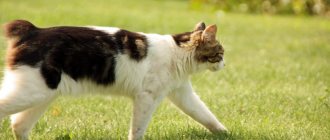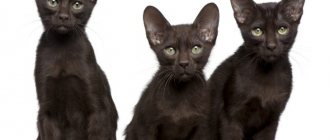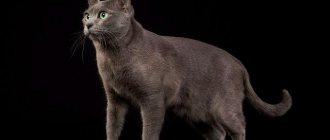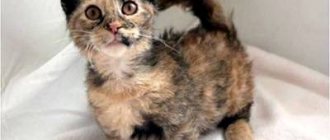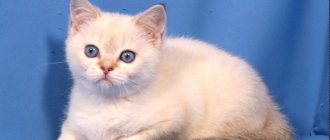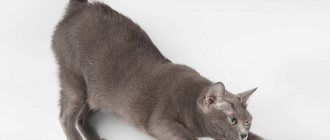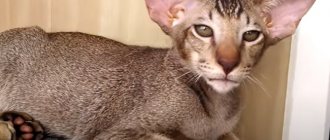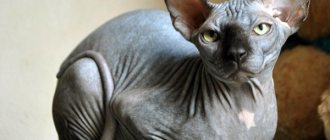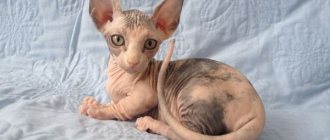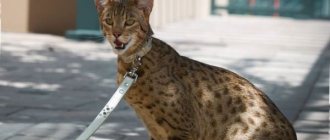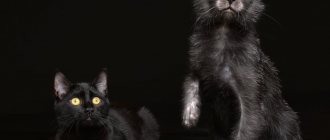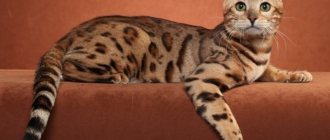Savannah is the name given to a large breed of cat, bred by crossing wild cat servals and familiar domestic cats. The main features of savannahs include their large size, striking resemblance to wild servals, extraordinary devotion, as well as high cost, which reaches 22 thousand dollars. Now these cats are considered the most expensive in the world.
History of the origin of the breed
The origin of the Savannah is unusual, it belongs to the category of short-haired cats, the color of its coat resembles that of a cheetah. The rare features of these cats are explained by their exotic origin. The birth of the breed is usually dated back to the mid-80s of the twentieth century. Breeders from the USA set out to create a completely new breed of large domestic cats that look like cheetahs. Mainly due to the spotty coloration. For this purpose, attempts were made to cross Servals, wild African cats, distant relatives of the lynx, with a characteristic vertical ear arrangement, with domestic cats, Siamese, Bengal, Egyptian Mau and some other short-haired breeds. The serval was chosen as one of the parents not only for its bright appearance, but also for its intelligence, training, and friendliness.
The breeders have done a truly tremendous job. Even the selection of cats for mating in this case is difficult, not to mention the process itself. Representatives of the selected breeds differed greatly in size and temperament.
We recommend reading the article about servals on the Mister Cat portal.
On April 7, 1986, thanks to the efforts of D. Frank, the first pair of kittens was born. The breed standards, which were approved by TICA, were developed by breeders J. Sroufe and P. Kelly. TICA officially recognized the savannah in 2001.
It is interesting that the breed is still not recognized by other organizations of felinologists. It is believed that not enough time has passed for its signs to consolidate; they are unstable in manifestation and the number of savannahs is still small.
What is the difference between a Savannah and a Bengal cat?
Despite the similarities in appearance, the Savannah cat and the Bengal cat have a number of significant differences.
- The pedigree of Bengal cats originates from the Far Eastern cats, and in the savannas - from African servals.
- If you look closely at Savannahs and Bengals, differences in the coloring of the skin are visible to the naked eye. In Bengals it is dotted with dark spots of three different colors. Savannahs have spots of the same tone.
- Distinctive features are manifested in the structure of the body. The Bengal breed has a compact body, like an American football player. These are cats with small ears and large round eyes. But Savannah is compared to a tall basketball player. They have big ears.
Diseases of Savannah cats
Representatives of this Savannah breed, regardless of whether they are cats or males, are distinguished by excellent health and practically do not get sick; breeders associate this fact with the strong heredity of the Serval. They have a very strong immune system, so they are less susceptible to colds than other pets.
The lifespan of animals is 17-20 years, the main thing is to provide them with good caring care, a spacious room for active games and walks in the fresh air.
Appearance
According to established standards, these cats have a flexible, slender, elongated body. The cat looks heavier than it actually is. It stands out for its very large, rounded ears. Limbs are long and strong. The hind legs are longer than the front legs, like those of large cats. The tail is long and straight. The short fur of a Savannah kitten is very soft and thick. The undercoat is soft, dense, evenly distributed throughout the body. Another feature is that the paws are round, small in size, and colored charcoal or dark brown. Savannah is distinguished by its noble posture and natural grace. Unlike the British, who are considered to be such “bumps” in the cat world.
Standard colors: cinnamon tabby, chocolate, gold-silver, brown.
The largest representative of domestic cats. Height at the withers is up to 60 cm, weight is 13-15 kg. They reach their maximum size at 3 years. Savannahs live for about 15 years.
Character
Character is influenced by 3 main factors: parental behavior, generation, socialization. Since the breed is still at an early stage of development, animals of different generations differ significantly in character.
The first generation Savannah cat (F1 or F2) will behave more actively and even wildly. This is reflected in the nature of servals, which are characterized by jumping, hunting and tracking. Fertile F5 and F6 cats are already used for breeding. The resulting offspring has a character more familiar to all owners of domestic cats. But, nevertheless, all generations are characterized by excessive curiosity and high activity.
An interesting combination of love of freedom and easy-going characterizes all cats of the Savannah breed.
They adapt well to various conditions, show interest in things around them, and tolerate coexistence with other pets.
These cats are extremely mobile, jumping, and require a lot of space for a comfortable life. Unlike other cats, they are not only not afraid of water, but enjoy bathing. They even prefer to drink ordinary water from large containers, which apparently remind them of the reservoirs familiar to their ancestors. These cats do not protest when they are walked on a leash, which once again demonstrates their “dog-like” character.
The main characteristic is devotion, which is often compared to that of a dog. Wagging the tail as a greeting is also more of a dog than a cat sign.
Such cats get along with children from 5 years old (but not with toddlers), because they are calm and enjoy playing for hours on end. They have a high level of intelligence (some felinologists highlight this trait significantly) and are trainable. But they also require a lot of attention.
When raising them, it is important to take into account that they need early socialization. Kittens that communicate with people from their first days quickly get used to life in a family, learn behavior and habits. But in one litter there can be both more active and sociable kittens and more timid ones. Therefore, you need to communicate with the latter, play more actively, and encourage them more often than active, fearless kittens.
Character of Savannah cats
Savannah cats are extremely intelligent and intelligent animals that can be trained. Moreover, you can teach them not only the simplest commands, but also quite “dog” ones, such as “Fetch!”
They are very sociable and inquisitive, getting along well with other animals living in the house, especially dogs, but only if they lived together from the very beginning. It is difficult to imagine how a cat, which always feels like a leader, will behave if a small puppy is suddenly brought into the house. Maybe she'll become friends with him. What if her hunting instinct kicks in? Therefore, it is better not to take risks.
But the small children of the savannah simply adore them and gladly take part in the kids’ fun. They will never show aggression or offend a child.
They become very attached to their owner, and such devotion creates certain problems. If the owner needs to leave for a while, it will be impossible to leave the cat with strangers, since it does not accept strangers. In this case, it is better to take the Savannah with you - she will gladly accompany her owner on the journey.
Some representatives of the breed can behave extremely unfriendly with strangers, get scared, run away and even hiss, while others are quite well socially adapted and behave friendly. But in any case, a cat’s behavior is shaped by its upbringing and the person’s attitude towards it.
These animals cannot be called affectionate. If the kitten is still sweet and good-natured, then as it grows older it will increasingly begin to show character traits characteristic of its wild ancestors. Based on this, it is recommended to keep your pet outside in a special fenced enclosure.
In addition, these big cats are very active and jumping, they run and jump a lot (they can quite jump from a standing position to a height of up to 2.5 meters), so they are more suitable for living in private houses with summer cottages than in small apartments. Moreover, cats marked F1 have higher activity.
INTERESTING TO KNOW: The most patient and balanced ragdoll cat
Walking with the Savannah is a must; this breed is not suitable for purely domestic keeping. When taking your animal for a walk, you must use a leash. She will quickly get used to it and will not experience discomfort.
Savannah loves water, and if the owner wants to entertain her, he can simply pour water into a basin and throw in a few bright toys. The animal's delight knows no bounds!
The only drawback of this breed is the animal’s habit of marking its territory, so if the cat lives not in an outdoor enclosure, but in an apartment, then there will always be a specific smell in the room.
A rare Savannah cat will quickly get used to the litter box, but experts recommend teaching him to tolerate it outside like a dog.
Pros and cons of the breed
Pros:
- Non-standard, exotic appearance.
- Intelligence and natural curiosity.
- Unlimited loyalty to the owners.
- They are easy to train.
- Relatively unpretentious in care.
- Peaceful - gets along well with other cats and dogs.
- They quickly adapt to new conditions, so they are easy to travel with.
Minuses:
- High price.
- You need to walk them a lot, like dogs.
- Sometimes extremely mobile.
- Willful and independent.
- Due to its large size and active behavior, it is not recommended to have it in a home with small children.
Care and maintenance of Savannah cats
Savannah does not require special care. Its magnificent spotted coat should be combed once every two weeks and it should be regularly given water treatments, but not for the purpose of washing the animal, but in order to give it the opportunity to enjoy the water that Savannah cats simply adore. Necessary hygiene procedures include wiping eyes, brushing teeth, ears and trimming nails.
Savannahs are heat-loving animals and cannot tolerate cold, so the room where they are kept must be warm.
You can feed the savannah with natural food or industrial feed; the owner himself will choose the best option, but you should be aware of some nuances. The diet must be enriched with proteins and vitamins so that the energy of hyperactive animals is replenished.
A cat should not be given food with a high grain content; the animal’s digestive system has difficulty digesting it. It is strictly not recommended to give milk and other fermented milk products, as this can lead to stomach upset.
The main product in the diet should be lean meat and offal; you can give minced chicken, but you should not give fish, because this product is not present in the natural diet of a predator.
If preference is given to ready-made food, then it should be super premium. This is not a cheap pleasure, but if a person has already afforded such an expensive purchase as a cat of this rare breed, then he will be able to provide it with high-quality nutrition.
Breeding and care
Descendants from crossing servals with domestic shorthair cats, Bengal, Siamese, Egyptian Mau and others are designated F1 (that is, descendants of the first generation). They have 53% blood of wild servals. All males, up to the fourth generation, are sterile. Each subsequent generation is designated by the F indicator with the corresponding numerical index. The descendants of F2 have only 29% Serval blood, and so on down the line, down to F7. The higher the percentage of Serval blood in the descendant, the more similar in appearance it will be to him. Savannahs designated F1-F3 are descendants of earlier generations. For them, the percentage of Serval blood is indicated in parentheses after the generation designation. They are the ones most valued by breeders of the breed and those wishing to acquire kittens.
To overcome physiological and behavioral problems, partners selected for mating are kept together from childhood. Significant biological differences between breeding breeds also affect the bearing of offspring.
This breed is unpretentious. Savannahs do not require special care. You just need to brush them regularly. It is advisable to equip a special enclosure, spacious enough, with equipment for climbing and jumping. The enclosure should only be used for its intended purpose—for cat walks. But in no case for permanent stay, since they value freedom of movement and will not tolerate confinement.
Nutrition and health
Savannahs are recommended to eat a balanced diet, preferably premium food. It is important to avoid high grain content and it is advisable to add taurine to your food. A little fresh meat in their daily diet prolongs their life.
You should not offer these cats fermented milk products - it may cause stomach upset. Free and constant access to clean water is required.
Savannah cats have good health and immunity. It is possible that this is due to the breeding characteristics of the breed. They only note that in older age they sometimes develop complications with liver function. Similar problems are typical for the serval.
Do not neglect vaccination against diseases common to all cats. In addition, this is still a domestic cat, so it is important to carefully examine it after returning from walks.
Breeding Savannah cats
Breeding cats of this rare breed is difficult. Experts note that every year the savannah is increasingly losing its genetic characteristics (African genes), as well as the external signs of a predator.
Felinologists have developed three conventional levels of offspring:
- F1. The first hybrid generation obtained from mating a serval with a domestic cat. The ratio of genes is 50 to 50.
- F2. The second hybrid generation obtained from crossing an F1 Savannah and a domestic cat. Predator genes no longer exceed 30%.
- F3. The third hybrid generation, Savannah F2 is crossed with Serval. Predator genes - no more than 13%.
Further crossing is pointless; with each generation, the Savannah becomes more and more like a domestic cat, so F1 and F2 individuals are considered the most valuable.
Breeders tried to cross a female serval with a regular cat, with the percentage of the wild gene being 75, but these are isolated cases and it is impossible to buy such a cat. Only females of this breed are endowed with the ability to reproduce; males are infertile until the 4th generation.
